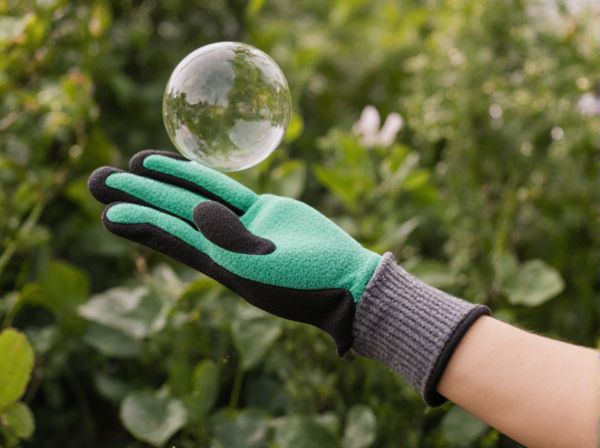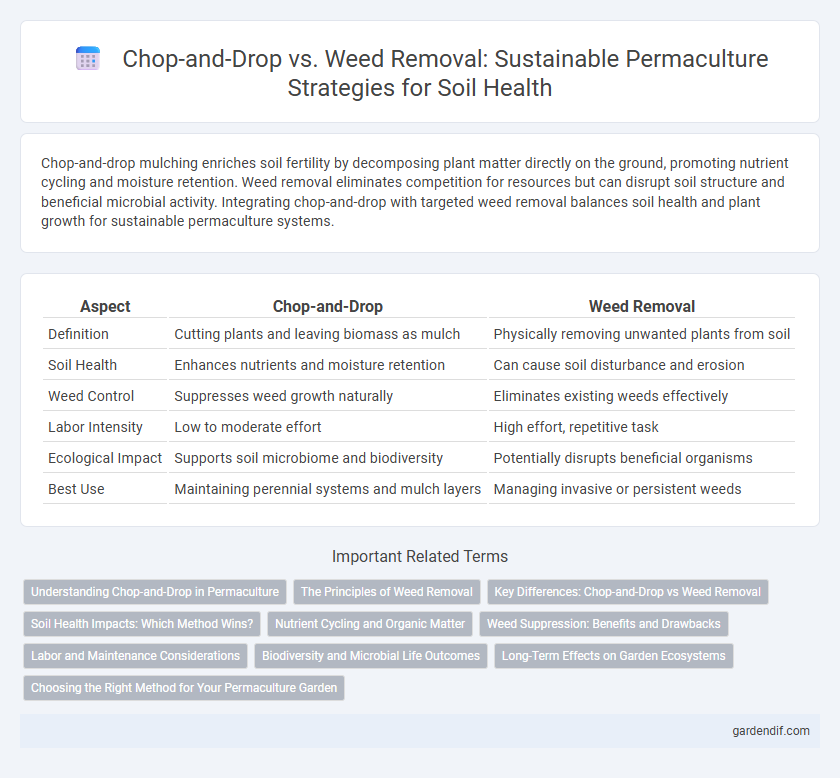
Chop-and-Drop vs Weed Removal Illustration
Chop-and-drop mulching enriches soil fertility by decomposing plant matter directly on the ground, promoting nutrient cycling and moisture retention. Weed removal eliminates competition for resources but can disrupt soil structure and beneficial microbial activity. Integrating chop-and-drop with targeted weed removal balances soil health and plant growth for sustainable permaculture systems.
Table of Comparison
| Aspect | Chop-and-Drop | Weed Removal |
|---|---|---|
| Definition | Cutting plants and leaving biomass as mulch | Physically removing unwanted plants from soil |
| Soil Health | Enhances nutrients and moisture retention | Can cause soil disturbance and erosion |
| Weed Control | Suppresses weed growth naturally | Eliminates existing weeds effectively |
| Labor Intensity | Low to moderate effort | High effort, repetitive task |
| Ecological Impact | Supports soil microbiome and biodiversity | Potentially disrupts beneficial organisms |
| Best Use | Maintaining perennial systems and mulch layers | Managing invasive or persistent weeds |
Understanding Chop-and-Drop in Permaculture
Chop-and-drop in permaculture involves cutting plants or weeds and allowing them to decompose naturally on the soil surface, enriching soil fertility and retaining moisture. This method supports soil microbial activity, improves nutrient cycling, and suppresses weed growth by creating a protective mulch layer. In contrast to traditional weed removal, chop-and-drop minimizes soil disturbance, promoting long-term soil health and ecosystem stability.
The Principles of Weed Removal
The principles of weed removal in permaculture emphasize minimizing soil disturbance and promoting biodiversity to maintain ecosystem balance. Chop-and-drop techniques naturally suppress weeds by mulching and enriching soil organic matter, reducing the need for manual weeding or chemical herbicides. Effective weed management aligns with permaculture ethics by fostering healthy soil, supporting beneficial organisms, and conserving water.
Key Differences: Chop-and-Drop vs Weed Removal
Chop-and-drop involves cutting plants and leaving the organic matter on the soil surface to decompose, enriching soil fertility and retaining moisture, while weed removal entails extracting unwanted plants entirely to reduce competition and prevent seed spread. Chop-and-drop supports soil health by recycling nutrients in situ, whereas weed removal primarily focuses on immediate eradication of invasive species without directly contributing organic matter. The choice between these methods depends on the specific goals of soil improvement versus aggressive weed control within permaculture systems.
Soil Health Impacts: Which Method Wins?
Chop-and-drop enhances soil health by returning organic matter and nutrients directly to the ground, promoting microbial activity and moisture retention. Weed removal disrupts soil structure and exposes it to erosion, potentially reducing beneficial microbial populations and nutrient cycling. For sustainable soil regeneration, chop-and-drop consistently outperforms weed removal in maintaining soil fertility and ecosystem balance.
Nutrient Cycling and Organic Matter
Chop-and-drop enhances nutrient cycling by allowing chopped plant material to decompose in place, recycling essential nutrients back into the soil and increasing organic matter content. In contrast, weed removal often exports biomass from the system, potentially depleting soil organic matter and disrupting natural nutrient flows. Maintaining organic matter through chop-and-drop practices supports soil structure, moisture retention, and microbial activity, crucial for sustainable permaculture systems.
Weed Suppression: Benefits and Drawbacks
Chop-and-drop mulching enhances weed suppression by creating a thick organic layer that blocks sunlight and reduces weed seed germination, promoting soil fertility and moisture retention simultaneously. Weed removal physically eliminates unwanted plants but can disturb soil structure and expose weed seeds to germination triggers, potentially increasing weed pressure over time. Balancing chop-and-drop with targeted weed removal supports sustainable weed management by minimizing soil disruption while maintaining effective suppression through continuous ground cover.
Labor and Maintenance Considerations
Chop-and-drop permaculture techniques significantly reduce labor and maintenance by allowing organic matter to decompose naturally on-site, minimizing the need for frequent weeding and soil disturbance. Weed removal requires consistent manual effort or mechanical intervention, increasing labor intensity and potentially disrupting soil structure and beneficial microorganisms. Incorporating chop-and-drop practices enhances soil fertility with minimal ongoing labor, promoting sustainable ecosystem balance.
Biodiversity and Microbial Life Outcomes
Chop-and-drop enhances soil biodiversity by returning organic matter directly to the ground, fostering diverse microbial communities essential for nutrient cycling and plant health. In contrast, traditional weed removal disrupts soil structure and reduces habitat complexity, leading to diminished microbial diversity and slower organic matter decomposition. Emphasizing chop-and-drop methods in permaculture supports resilient ecosystems by promoting symbiotic relationships among soil organisms, plants, and decomposers.
Long-Term Effects on Garden Ecosystems
Chop-and-drop mulching enhances soil fertility by returning organic matter and nutrients directly to the garden bed, promoting microbial activity and moisture retention for sustainable plant growth. In contrast, frequent weed removal can disrupt soil structure and reduce beneficial habitat for pollinators and soil organisms, potentially leading to long-term ecosystem imbalance. Emphasizing chop-and-drop techniques supports resilient garden ecosystems through improved nutrient cycling and reduced erosion.
Choosing the Right Method for Your Permaculture Garden
Chop-and-drop enhances soil fertility by mulching organic matter directly onto garden beds, promoting nutrient recycling and moisture retention in your permaculture system. Weed removal is crucial for minimizing competition and preventing invasive species from disrupting plant growth and soil health. Selecting the right method depends on your garden's plant diversity, soil condition, and long-term sustainability goals, ensuring balance between weed control and ecosystem functionality.
Chop-and-Drop vs Weed Removal Infographic

 gardendif.com
gardendif.com